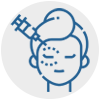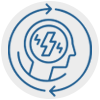Explore this page:

Overview
Chronic pain is often defined as any pain lasting more than 12 weeks and can range in intensity from mild to severe. Most types of pain resolve after the physical injury heals. However, chronic pain can last for months and even years after the physical injury heals. In fact, this type of pain can occur when there is no known trigger for the pain.
Chronic pain has reached epidemic proportions in Canada, with millions of people suffering from it daily. Since chronic pain is psychologically difficult to endure, it can often trigger anxiety and depression.
This debilitating condition is often associated with other health problems, including fatigue, sleep disturbance, decreased appetite, and mood changes. There are many options for chronic pain management that can help to provide relief and help you get your life back.
What are some types of chronic pain?
Chronic pain can be caused by a wide range of conditions.
Here are some of them:
Headache
Headache is a type of pain that occurs in the head or upper neck, and around 50% of adults will experience a headache at least once a year. When occurring frequently, headaches can be a source of chronic pain.
Headaches are typically classified into three broad categories:
- primary headaches
- secondary headaches
- cranial neuralgias
- facial pain
- and other headaches
Some of the most common types of headaches include tension headaches, sinus headaches, migraines, and rarely cluster headaches.
Chronic migraine
Migraines are a type of primary headache involving recurring headaches of moderate to severe intensity and that last anywhere from several hours and up to three days.
Migraines typically occur on one side of the head, and are often felt as pulsating pain, and are accompanied by nausea, vomiting, increased sensitivity to light and smells, or by visual disturbances referred to as “aura.” Chronic migraine is a debilitating condition defined as having more than 15 headache days for month.
Whiplash injury
Whiplash is a type of neck injury caused by the sudden and forceful movement of the head forward, backward, or sideways. This type of motion can cause a lot of damage to the neck by causing fractures in the bones of the spine, as well as injury to the discs between the bones.
In addition, whiplash injuries often cause damage to the ligaments, nerves, muscles, and other tissues in the neck. Often, a whiplash injury can result in chronic pain symptoms that require treatment.
Postherpetic neuralgia
Postherpetic neuralgia is neuropathic pain which occurs as the common complication of shingles, caused by the chickenpox virus (herpes zoster). This condition results from damage to peripheral nerves during the shingles outbreak, causing burning pain.
Postherpetic neuralgia affects nerve fibers and skin, causing burning pain that lasts long after the rash and blisters of shingles disappear, persisting for more than 3 months after the shingles rash has healed.
Disorders of the Nervous System
Many disorders of the nervous system are associated with chronic pain, including multiple sclerosis, complex regional pain syndrome, post-stroke pain. This type of chronic pain can be highly debilitating and often requires treatment.
Locomotor Disorders
Chronic pain is often associated with movement disorders such as Parkinson’s disease, dystonia, cerebral palsy, Huntington’s disease, and spasmodic torticollis.
Typically, symptoms such as aching, numbness, stiffness, poor posture, and tingling present in these disorders are closely linked to chronic pain.
Acute/Biomechanical Disorders
The body’s biomechanical equilibrium can be negatively affected by acute or chronic injury or factors such as abnormalities in muscle strength and joint dysfunction.
Biomechanical disorders are often linked to chronic pain. Mechanical back pain is one such common disorder, often resulting in significant disability and a negative impact on one’s quality of life.
What are the symptoms and causes of chronic pain?
Chronic pain is characterized as pain lasting longer than 3 months. It can be caused by a variety of conditions. This type of pain may arise from physical injuries, such as a back sprain, or an ongoing illness.
Sometimes, there is no clear cause that can be found. Chronic pain can change the way neurons (nerve cells in the brain and spinal cord) transmit and process sensory information and become hypersensitive to pain messages.
How is chronic pain tested and diagnosed?
To test and diagnose chronic pain, your health practitioner will first take a detailed medical history. There are several tests that are used to examine and diagnose chronic pain, including laboratory blood tests, imaging tests such as X-rays and MRI scans, musculoskeletal and neurological exams, and electrodiagnostic tests, including nerve conduction studies and electromyography.
What are the treatment options for chronic pain?
Chronic pain can seriously interfere with one’s quality of life. Our pain specialists use a multidisciplinary, non-narcotic approach to chronic pain treatment, creating individualized treatment plans tailored to each patient’s requirements.
The goal of our specialized chronic pain treatment is to reduce pain and improve function, so our patients can resume daily activities.
We offer chronic pain treatments following treatments for chronic:
Nerve block injections
A nerve block is an injection used to decrease inflammation or “interrupt” a pain signal along a specific nerve or bundle of nerves. Essentially, this is a method of producing anesthesia and produces a loss of feeling to prevent or control pain sensation. Nerve blocks can be performed on various nerves in many parts of the body, depending on the cause of chronic pain.
Botox® injections
Headache, Migraine & Concussion Centre offers Botox® treatment for chronic migraine headaches, a highly disabling condition that can significantly affect one’s quality of life.
Botox® injections treatment involves injections of one of the forms of botulinum toxin, which is a protein produced by the bacterium Clostridium botulinum and species related to it.
In turn, this toxin blocks signal transmission from nerves to muscles, resulting in muscle relaxation and providing chronic pain relief.
Osteopathic Manual Manipulation (connective/soft tissue)
Osteopathy therapy, practitioners use their hands to work on muscle and joint tissues by applying pressure to them. This type of therapy can be used to reduce chronic pain associated with muscle spasms, muscle tension, or joint function problems. Moreover, individual, structured exercise programs are provided for patients to continue treatment at home.
Acupuncture
Acupuncture is an ancient medical practice based on traditional Chinese medicine and can be used to manage chronic pain. Needle acupuncture is the most common type of acupuncture and involves the insertion of fine filiform needles, typically made of steel (but sometimes made of silver or gold), into specific acupuncture points on the body.
Auricular Acupuncture
This acupuncture method involves using the acupuncture points located in the ear, which, according to traditional Chinese medicine, are believed to represent all other areas of the body. Very fine needles or ear “seeds” or tacks are used to stimulate ear acupuncture points.
Cupping
In this acupuncture technique, glass suction “cups” are applied to the surface of the skin to relieve muscle and skin inflammation, improve the blood flow, and relax the nervous system. This technique is often used to treat eczema, muscular pain, headaches, colds, and arthritis. Often, the cupping technique is used in conjunction with body acupuncture but can also be used alone.
Tui-na massage/Gua-Sha
This technique combines the use of acupuncture, therapeutic massage, and other forms of body manipulation in order to achieve muscle relaxation. Tui-na is often used to treat superficial trauma and injury, as well as a variety of musculoskeletal problems. In turn, Gua-sha is the ancient Chinese practice for improving the body’s energy flow and blood circulation and involves using a flat tool to scrape the surface of the skin.
Low-level laser therapy
Concussion
A concussion is a type of mild traumatic brain injury, often caused by a bump, blow or jolt to the head. Most people recover from the concussion completely, and their symptoms disappear.
Some individuals who sustained a concussion (up to 30-40%) may continue to experience long-term symptoms of a concussion. This is called post-concussion syndrome, and individuals who develop this syndrome continue to experience symptoms after six weeks following injury.
In some individuals, chronic pain symptoms can develop after sustaining a concussion or as part of post-concussion syndrome.






